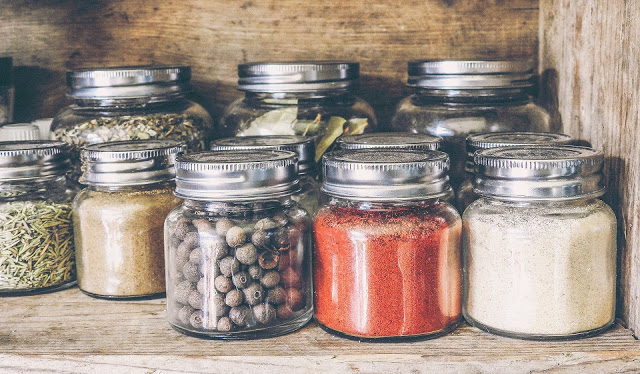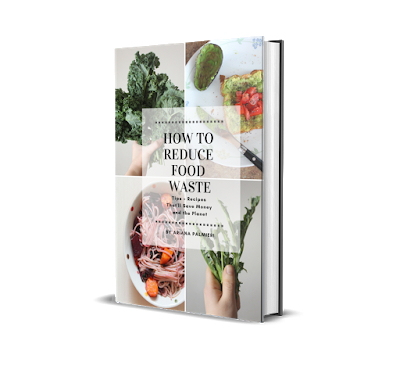Planning out your meals can really help you reduce the amount of food you waste in your home. I recommend creating a meal plan and a shopping list to help keep you on track.
Step 1 – Learn the way you eat
Sometimes, we just buy things and eat mindlessly without observing our own patterns. However, the key to planning out our meals comes from asking ourselves some eye opening questions. It’s time to get reflective and realize the relationship we have with our food.
Here are a few questions you should ask yourself:
- Do I live with other people? If so, what do they like to eat (any household favorites)?
- How much do I need to buy to feed “X” amount of people?
- Are there any foods my family does not like eating?
- Do I plan to eat out this week? If so, how often?
- Are there any leftovers I can incorporate into this week’s meal plan?
- What’s already in my fridge and pantry I can use up this week and don’t need to restock?
Asking yourself these questions will help you plan out what to buy much better.
Step 2 – Make a meal plan
After you ask yourself some reflective questions, it’s time to create a meal plan for the week. On a piece of scrap paper, write what dishes you’d like to make for breakfast, lunch and dinner every day this week.
Here’s an example of a meal plan for a Monday:
Monday:
Breakfast – Oatmeal with fresh strawberries
Lunch – Sandwich with lettuce, ham, pickles and tomatoes
Dinner – Pasta with tomato sauce
You’d repeat this for all seven days of the week to create a weekly meal plan. You can also write little notes on your meal plan. For example, perhaps make a note to prep certain things on Sunday to make your life easier throughout the week (like making a pot of rice or pasta, sauteing some vegetables, cooking some meat, etc.). This will help you have less work to do over the course of the week and be a good reminder for you.
Step 3 – Create a grocery list
Now that you know the meals you’d like to create for the week, write a list of all the ingredients you’d need for those meals. For example, if you plan on making oatmeal one day this week for breakfast, do you have enough oatmeal at home, or will you need to buy more? Check your pantry and fridge before buying ingredients at the store! You want to use items up before they go bad.
It helps if you include quantities on your grocery list too. So for example, write “4 tomatoes” instead of just writing “tomatoes” on your list. This will help you not over-buy anything.
At the bottom of your grocery list, consider writing down the items you already have at home, as a reminder to yourself. This way, you’ll remember you don’t have to buy these items at the store.
Learning how to store your food properly will cut back on how quickly things start to go bad.
There are several things to take into consideration when you store food, such as:
- Temperature
- Lighting
- Humidity
- Proximity
Food is very sensitive to all four of these things: If your food spoils ahead of time, you might be storing certain foods the wrong way.
Here’s exactly where to store your food so they don’t spoil quicker:
- Keep in fridge, 40 degrees F or lower: Grapes, apples, berries, cherries, broccoli, carrots, leafy greens, green beans, cauliflower, and asparagus. Wait to wash berries off until you want to eat them to prevent mold. Also, anything that has been cut up needs to be kept in the fridge to prevent food borne illness.
- On the counter, away from direct sunlight: Squash, melons, and tomatoes. This will keep them fresh.
- Dark place: Potatoes, onions and sweet potatoes. A pantry or cupboard works well.
- Ripen on the counter and then stored in the refrigerator: Avocados, pears, nectarines, plums, and peaches.
Sometimes, even with planning and proper storage, you have to improvise. And that’s okay! Life gets in the way of being absolutely perfect all the time. In those moments, it’s important to get thrifty with your food.
As always, I encourage you to shop your kitchen first before buying new food. Cook, eat, or prepare what you already have at home before buying more.
When you do go to the store to buy food, know the difference between the “sell-by”, “use-by”, and “best-by” labels. They’re all different and should be taken into account when purchasing food.
- Best if Used By/Before: Indicates when a product will be of best flavor or quality. It is not a purchase or safety date.
- Sell-By: Tells the store how long to display the product for sale for inventory management. It is not a safety date.
- Use-By: Is the last date recommended for the use of the product while at peak quality. It is not a safety date except when used on infant formula.
As you can see, absolutely none of them mean the food has spoiled (unless talking about infant formula). This means you don’t have to be intimidated by these dates! Don’t throw food away simply because these dates scare you any more. Knowing the meanings of these dates really helps you save money and not waste food simply because you think it’s expired (when it’s not).
Being thrifty with your food also means utilizing what you already have, down to the very last drop.
Here are a few other ways to be thrifty with your food:
- Make vegetable broth from food scraps (before composting them).
- Learn how to can and freeze excess garden vegetables.
- Pickle any vegetable you haven’t gotten around to eating and don’t want to rot.
- Make your own jam out of slightly bruised/imperfect/overabundant berries.
- Stop peeling your vegetables and just brush them clean instead (eating the peels is good for you, if they’re organic).
- Have a leftovers night where your main goal is to finish all of them.
Sometimes, there’s just too much food to eat. Have a few cans of corn, chickpeas, or beans you haven’t gotten around to eating? Donate it! There are so many food pantries, homeless shelters and food banks that could really use the help.
A great website to check out is Feeding America. You can search for local food banks in your area on their site. Just type in your zip code or state. When you find a food bank near you, reach out to them and ask them what food donations they accept. It may already be listed on their website, or you might have to call them. Either way, you should always look in your own home first to see if you have any excess food to donate to them before going out and buying more.
If you garden, and tend to have more produce than you know what to do with, you can look into donating it to local food pantries. Often times, fresh produce is one of the most valuable things a food pantry can get. After all, fresh produce will always have more nutrients than canned foods! Ample Harvest is a great website that can help you locate food pantries in your area that accept fresh produce donations.
With so many starving people in this world, it’s important now more than ever to donate your excess food. If you’re feeling really motivated, perhaps look into volunteering with a local soup kitchen or food pantry. Perhaps even consider starting a food drive of your own and giving all the collected food to your local pantry. Every little bit helps!
No matter what, you’re bound to have food scraps. It’s inevitable. Some examples of food scraps include avocado skins and pits, egg shells and peeled potato skins. Instead of throwing these scraps into the trash, where they’ll head straight to landfill and produce methane gas, compost them.
Composting is so easy. Even if you have limited space and live in an apartment (like me), you can still do it. Compost is essentially just organic matter that’s decomposed. You can use compost in the garden as a soil conditioner to help fertilize your plants, improve soil quality and so much more.
Here’s what you can (and cannot) compost.
Do compost:
- Egg shells
- Nut shells
- Fruit pits
- Fruit & vegetable ends/scraps
- Coffee grounds
- Tea leaves
- Tea bags (non-plastic)
- Paper (non-glossy)
- Cardboard
- Yard waste (grass, leaves, twigs, etc.)
- Natural fabrics in small pieces (cotton, hemp, wool, silk, linen)
- Herbivore manure
- Flowers + plant matter
- Hair (human or animal)
Don’t compost:
- Meat
- Dairy
- Oil
- Bones
- Bleached or laminated paper products
- Coffee cups
- Cat litter
- Omnivore manure
Here are a few simple ways you can start composting ASAP:
- Grab an empty container and start filling it up with your food scraps every time you’re in the kitchen. Put it in your fridge or freezer. At the end of the week, take it to your local farmers market which should have a food scrap drop off center. Dump it out and repeat the process.
- Find a local community garden you can dump your food scraps at, if there’s no farmers market available.
- If you have some money to invest, purchase a stainless steel compost pail that you can leave on your kitchen counter. Simply open the lid and plop in your scraps as you create them. This is what I prefer to use. Mine keeps things completely odor free and fruit fly free because of the built in charcoal filter!
- Got outdoor space? Try a tumbler compost bin. You can place it in full sun or shade, but make sure it has good drainage. Add your food scraps to it along with dry leaches, twigs, paper, and mulch. Make sure to mix it once a week. Your compost is ready when it smells and looks rich and earthy, no remnants of food scraps visible. You can add it to your garden immediately, or bag it and give it to a neighbor.
Want more tips on how to fight food waste? You’re in luck.
My ebook, How to Reduce Food Waste: Tips + Recipes That’ll Save Money and the Planet, just launched!
For a one time purchase of $15, you’ll be able to download it right away.
How to Reduce Food Waste covers the five topics I talked about in this post, along with sharing tons of valuable tips, tricks and recipes to help you reduce food waste. I’ve been working on this ebook behind the scenes for a while now (months, in fact) and I’m super excited to share it with you!
After reading How to Reduce Food Waste you can expect to:
- Have a better understanding of what food waste and food loss are.
- Learn how to properly plan, store, thrift, donate and compost all your food.
- Create delicious zero waste meals that fight food waste.
- Develop a deeper relationship with your food, where it comes from, and where it ends up.
- Save money by reducing the amount of food you throw away.
I’ve divided the ebook into two sections: Part one tackles how to reduce food waste while part two contains 14 delicious zero waste recipes. These recipes will help you reduce your carbon footprint in multiple ways!
Here’s a sneak peak at the recipes you’ll get in How to Reduce Food Waste:
- Avocado Toast + Salvaged Tomatoes
- Use-It-Up Vegetable Soup
- Homemade Vegan Pizza with Lonely Veggies
- Lavender Blueberry Nice Cream (pictured above)









Really nice post. Thank you for sharing amazing information.
Best Makeup Artist in Gurgaon
Makeup Academy in Gurgaon
Great info!